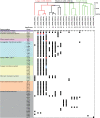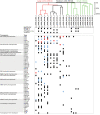Plasmid diversity among genetically related Klebsiella pneumoniae blaKPC-2 and blaKPC-3 isolates collected in the Dutch national surveillance
- PMID: 33033293
- PMCID: PMC7546619
- DOI: 10.1038/s41598-020-73440-2
Plasmid diversity among genetically related Klebsiella pneumoniae blaKPC-2 and blaKPC-3 isolates collected in the Dutch national surveillance
Abstract
Carbapenemase-producing Klebsiella pneumoniae emerged as a nosocomial pathogen causing morbidity and mortality in patients. For infection prevention it is important to track the spread of K. pneumoniae and its plasmids between patients. Therefore, the major aim was to recapitulate the contents and diversity of the plasmids of genetically related K. pneumoniae strains harboring the beta-lactamase gene blaKPC-2 or blaKPC-3 to determine their dissemination in the Netherlands and the former Dutch Caribbean islands from 2014 to 2019. Next-generation sequencing was combined with long-read third-generation sequencing to reconstruct 22 plasmids. wgMLST revealed five genetic clusters comprised of K. pneumoniae blaKPC-2 isolates and four clusters consisted of blaKPC-3 isolates. KpnCluster-019 blaKPC-2 isolates were found both in the Netherlands and the Caribbean islands, while blaKPC-3 cluster isolates only in the Netherlands. Each K. pneumoniae blaKPC-2 or blaKPC-3 cluster was characterized by a distinct resistome and plasmidome. However, the large and medium plasmids contained a variety of antibiotic resistance genes, conjugation machinery, cation transport systems, transposons, toxin/antitoxins, insertion sequences and prophage-related elements. The small plasmids carried genes implicated in virulence. Thus, implementing long-read plasmid sequencing analysis for K. pneumoniae surveillance provided important insights in the transmission of a KpnCluster-019 blaKPC-2 strain between the Netherlands and the Caribbean.
Conflict of interest statement
The authors declare no competing interests.
Figures





Similar articles
-
Plasmid Dynamics in KPC-Positive Klebsiella pneumoniae during Long-Term Patient Colonization.mBio. 2016 Jun 28;7(3):e00742-16. doi: 10.1128/mBio.00742-16. mBio. 2016. PMID: 27353756 Free PMC article.
-
Chromosomal Integration of the Klebsiella pneumoniae Carbapenemase Gene, blaKPC, in Klebsiella Species Is Elusive but Not Rare.Antimicrob Agents Chemother. 2017 Feb 23;61(3):e01823-16. doi: 10.1128/AAC.01823-16. Print 2017 Mar. Antimicrob Agents Chemother. 2017. PMID: 28031204 Free PMC article.
-
Emergence of Ceftazidime-Avibactam Resistance Due to Plasmid-Borne blaKPC-3 Mutations during Treatment of Carbapenem-Resistant Klebsiella pneumoniae Infections.Antimicrob Agents Chemother. 2017 Feb 23;61(3):e02097-16. doi: 10.1128/AAC.02097-16. Print 2017 Mar. Antimicrob Agents Chemother. 2017. PMID: 28031201 Free PMC article.
-
Outbreak of KPC-2-Producing Klebsiella pneumoniae ST76 Isolates in an Intensive Care Unit and Neurosurgery Unit.Microb Drug Resist. 2020 Sep;26(9):1009-1018. doi: 10.1089/mdr.2019.0363. Epub 2020 Mar 4. Microb Drug Resist. 2020. PMID: 32150494
-
Klebsiella pneumoniae and Klebsiella quasipneumoniae define the population structure of blaKPC-2Klebsiella: a 5 year retrospective genomic study in Singapore.J Antimicrob Chemother. 2019 Nov 1;74(11):3205-3210. doi: 10.1093/jac/dkz332. J Antimicrob Chemother. 2019. PMID: 31504571
Cited by
-
Genomic insight on Klebsiella variicola isolated from wastewater treatment plant has uncovered a novel bacteriophage.BMC Genomics. 2024 Oct 22;25(1):986. doi: 10.1186/s12864-024-10906-x. BMC Genomics. 2024. PMID: 39438783 Free PMC article.
-
Colistin-resistant Enterobacterales among veterinary healthcare workers and in the Dutch population.JAC Antimicrob Resist. 2022 Apr 19;4(2):dlac041. doi: 10.1093/jacamr/dlac041. eCollection 2022 Apr. JAC Antimicrob Resist. 2022. PMID: 35445193 Free PMC article.
-
Novel emm4 lineage associated with an upsurge in invasive group A streptococcal disease in the Netherlands, 2022.Microb Genom. 2023 Jun;9(6):mgen001026. doi: 10.1099/mgen.0.001026. Microb Genom. 2023. PMID: 37261428 Free PMC article.
-
Evidence of an epidemic spread of KPC-producing Enterobacterales in Czech hospitals.Sci Rep. 2021 Aug 3;11(1):15732. doi: 10.1038/s41598-021-95285-z. Sci Rep. 2021. PMID: 34344951 Free PMC article.
-
Plasmid genomic epidemiology of bla NDM carbapenemase-producing Enterobacterales in Canada from 2010 to 2023.Microb Genom. 2025 Aug;11(8):001415. doi: 10.1099/mgen.0.001415. Microb Genom. 2025. PMID: 40758767 Free PMC article.
References
MeSH terms
Substances
LinkOut - more resources
Full Text Sources

